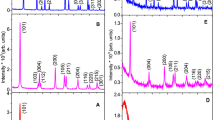Abstract
We have studied the effect of aging conditions on the properties of titania hydrosols produced via ultrasonic processing and containing aggregates of 5-nm-diameter amorphous particles. The results demonstrate that, at room-temperature, 0.44 M to 0.11 M hydrosols are stable for 3 to 22 days. During aging for 40 to 45 days, the properties of 0.01 M to 0.0025 M hydrosols remain unchanged. Aging for a longer time causes the amorphous particles to crystallize in the anatase structure. Raising the temperature to 75°C reduces the induction time to 3–4 h.
Similar content being viewed by others
References
Chen, X. and Mao, S.S., Titanium dioxide nanomaterials: synthesis, properties, modifications, and applications, Chem. Rev., 2007, vol. 107, no. 7, pp. 2891–2959.
Ismagilov, Z.R., Tsikoza, L.T., Shikina, N.V., Zarytova, V.F., Zinov’ev, V.V., and Zagrebel’nyi, S.N., Synthesis and stabilization of nanoparticulate titanium dioxide, Usp. Khim., 2009, vol. 78, no. 9, pp. 942–955.
Pelaez, M., Nolan, N.T., Pillai, T.S., Seery, M.K., and Falaras, P., A review on the visible light active titanium dioxide photocatalysts for environmental applications, Appl. Catal., B, 2012, vol. 125, pp. 331–349.
Macheswari, D. and Venkatachalam, P., Sol–gel synthesis and characterization of TiO2 nano films in the building of Dssc, J. Electron. Commun. Eng., 2013, vol. 4, no. 4, pp. 29–33.
Xu, Q. and Anderson, M.A., Synthesis of porosity controlled ceramic membranes, J. Mater. Res., 1991, vol. 6, no. 5, pp. 1073–1081.
Kozlowska, K., Lukowiak, A., Szczurek, A., Durek, K., and Naruszewski, K., Sol–gel coatings for electrical gas sensors, Opt. Appl., 2005, vol. 35, no. 4, pp. 29–34.
Ranganayaki, T., Venkatachalam, M., Vasuki, T., and Shankar, S.L., Preparation and characterization of nanocrystalline TiO2 thin films prepared by sol–gel spin-coating method, J. Innovative Res. Sci., 2014, vol. 3, no. 10, pp. 16707–16713.
Shen, G.X., Chen, Y.C., and Lin, C.J., Corrosion protection of 316 L stainless steel by a TiO2 nanoparticle coating prepared by sol–gel method, Thin Solid Films, 2005, vol. 489, nos. 1–2, pp. 130–136.
Jin, Y.S. and Choi, H.W., The effect of different TiO2 passivating layers on the photovoltaic performance of dye-sensitized solar cells, J. Ceram. Proc. Res., 2012, vol. 13, no. 2, pp. 178–183.
Anderson, M.A., Gieselmann, M.J., and Xu, Q., Titania and alumina ceramic membranes, J. Membr. Sci., 1988, vol. 39, no. 3, pp. 243–258.
Alphonse, P., Vartghese, A., and Tendero, C., Stable hydrosols for TiO2 coatings, J. Sol–Gel Sci. Technol., 2010, vol. 56, no. 3, pp. 250–263.
Wang, J., Yu, J., Liu, Z., He, Z., and Cai, R., A simple new way to prepare anatase TiO2 hydrosol with high photocatalytic activity, Semicond. Sci. Technol., 2005, vol. 20, no. 8, pp. 136–139.
Lee, D.S. and Liu, T.K., Preparation of TiO2 sol using TiCl4 as a precursor, J. Sol–Gel Sci. Technol., 2002, vol. 25, no. 2, pp. 121–136.
Zou, J., Gao, J., and Xie, F., An amorphous TiO2 sol sensitized with H2O with enhancement of catalytic activity, J. Alloys Compd., 2010, vol. 497, nos. 1–2, pp. 420–427.
Seok, S.I.I., Vithal, M., and Chang, I.Ah., Colloidal TiO2 prepared from peroxotitanium complex solutions: phase evolution from different precursors, J. Colloid Interface Sci., 2010, vol. 346, no. 1, pp. 66–73.
Shri, P.S. and Madhavan, J., Synthesis of TiO2 nanoparticles by ultrasonic assisted sol–gel method, Int. J. Chem. Technol. Res., 2013, vol. 5, no. 6, pp. 2970–2974.
Neppolean, B., Wang, Q., Jung, H., and Choi, H., Ultrasonic-assisted preparation of TiO2 nanoparticles. Characterization, properties and 4-chlorophenol removal application, Ultrason. Sonochem., 2008, vol. 15, no. 4, pp. 649–658.
Soderzhinova, M.M., Tarasova, D.V., and Chibirova, F.Kh., Ultrasound-assisted synthesis of titania hydrosols, Russ. J. Inorg. Chem., 2014, vol. 59, no. 8, pp. 801–806.
Baranchikov, A.E., Ivanov, V.K., and Tret’yakov, Yu.D., Sonochemical synthesis of inorganic materials, Usp. Khim., 2007, vol. 76, no. 2, pp. 147–168.
Author information
Authors and Affiliations
Corresponding author
Additional information
Original Russian Text © M.M. Soderzhinova, D.V. Tarasova, F.Kh. Chibirova, 2016, published in Neorganicheskie Materialy, 2016, Vol. 52, No. 5, pp. 517–522.
Rights and permissions
About this article
Cite this article
Soderzhinova, M.M., Tarasova, D.V. & Chibirova, F.K. Aging of titania hydrosols prepared via ultrasonic processing. Inorg Mater 52, 470–475 (2016). https://doi.org/10.1134/S0020168516050162
Received:
Accepted:
Published:
Issue Date:
DOI: https://doi.org/10.1134/S0020168516050162



